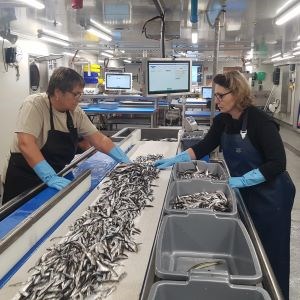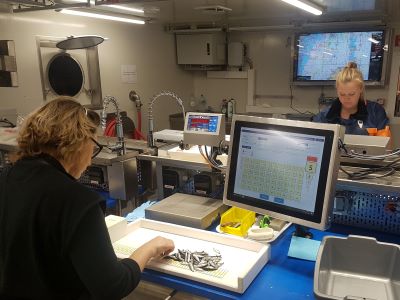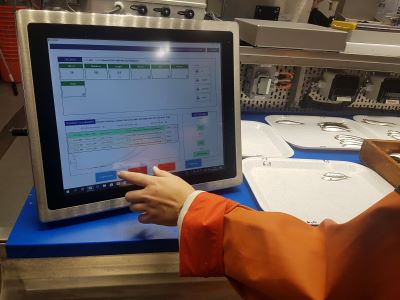Contact
Visit our Contact page to find contact information for the Software Development and Maintenance unit.

Every year, SLU undertakes several recurring trawl surveys on the North and Baltic Seas with its own research vessel, RV Svea. Svereg is the lab system on board used to quantify and register the catch.
The primary purpose is to regularly and scientifically monitor the fish stocks of these waters. The Swedish surveys are part of larger data frameworks and collaborations at Baltic and European levels. As well as collecting data for base science, several surveys are commissioned by the Swedish Agency for Marine and Water Management and are in order to fulfil Sweden’s obligations as an EU member state. The EU consider the collective state of fish stocks when setting fishing quotas, trying to maintain sustainable fishing levels in our shared waters.
Svereg facilitates the registration of the catch composition when trawling. Catches are sorted by classification with a weight for each. Further, staff sample and detail measure subsamples from the various classifications. Discard from classifications and samples are weighed too, and final enumerations are made. This is done to keep the time consuming detailed measurement work to a minimum while at the same time maintaining a qualified and representative estimate of the entire catch. Svereg is designed to support all areas of this approach. Because the depth of detail measurements varies considerably depending on the research plan and focus of the actual survey, Svereg is highly configurable per species and survey type.

Length measurement with a measuring board and Svereg. Photo: Mikael Ovegård, SLU
Seven permanent and a number of mobile touch screen PCs running the dot net application Svereg as a client form workstations along the labs production line.
Several variants of Bluetooth and USB digital measuring boards and callipers are connected at the workstations.
Specimen and bag tags are printed via any of the labs three Zebra label printers. QR codes from these can be scanned to via barcode scanners at each workstation.
Eight sea calibrated and IP connected table and floor weighing scales from Marel are installed in the lab.
The system has a dedicated virtual server in RV Svea’s IT infrastructure. It hosts the central SQL Server database which stores registrations, and which are shown in near real time on all workstations. The server also hosts Windows services integrating the Marel weighing scales. The database has an inbound integration with the Svepa system on the bridge, which announce incoming trawl catches to Svereg. The server hosts a SSIS package deployment for the outbound integration to the Oracle database Fiskdata2 on board. At the initiative of the lab head in Svereg, registered, validated and finalised data from Svereg is exported to Fiskdata2 station by station.
The Department of Aquatic Resources, SLU Aqua, are the owner and client for Svereg.
Representatives from the Institute of Marine Research, Lysekil, are scientific leaders for the surveys. Anders Svenson is their Svereg coordinator and is part of the maintenance team.
Svereg was developed by the Software Development and Maintenance unit in a development project together with staff from the Institute of Marine Research, Lysekil. The project lasted approximately eighteen months and the system was delivered to coincide with the launch of the research vessel RV Svea in the summer of 2019.
Since then, a maintenance team consisting of system developers and client side staff continue to work with further development, adaptation and life cycle management so that Svereg continues to support the clients requirements. Svereg is part of the collective maintenance object, FO Aqua.
Besides the main production environment on board Svea, there are also test and QA environments in Uppsala and Lysekil. These are used by developers for system testing and by the client side for acceptance testing and staff training.
Current maintenance management includes a yearly reviewed maintenance plan, monthly team meetings and planned releases every spring and autumn much in line with the clients seasonally established survey calendar.
SLU Aqua carried out many surveys before both RV Svea and Svereg became a thing. These were paper based collections that often meant weeks of after processing back on shore. Svereg is a completely paper free process from catch to report, and work is finished before RV Svea even makes it back to dock.
The system is scalable in terms of its workstations and their functions. This allows SLU Aqua to staff their expeditions appropriately in relation to the expected catch, frequency and measurement complexity. Staffing varies between 4 and 12 lab crew and the duration typically between 7 and 18 days at sea, of which some surveys are operative around the clock. System flexibility means workstations can be set up with dedicated equipment, and operators can choose to work alone, in line, or together in the material. The latter means that at the end of a late catch, everyone can help out and all can finish at the same time. That is appreciated.

Specimen measurement of fish with Svereg. Photo: Mikael Ovegård, SLU
The system is highly configured in order to proactively navigate the operator between pages depending on the current operation, species and workflow. The touch screens are relatively compact to keep repetitive movements small. Buttons are large, clearly defined and well separated. All these considerations are to make usage easier particularly on long passes in what is already a stressful and demanding work environment.
Visit our Contact page to find contact information for the Software Development and Maintenance unit.
Department of Aquatic Resources, SLU (SLU Aqua).
About RV Svea from the Ship Management Unit, SLU.